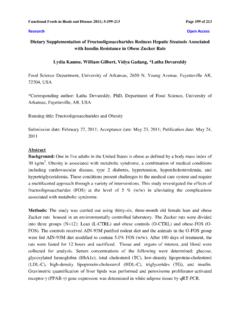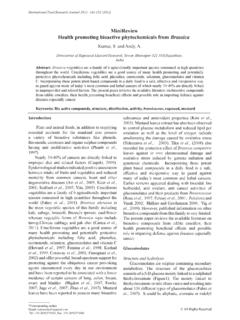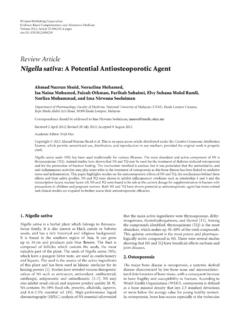Transcription of Plant flavonoids as angiotensin converting enzyme ...
1 Functional Foods in Health and Disease 2011; 5:172-188 Page 172 of 188 Research Open Access Plant flavonoids as angiotensin converting enzyme inhibitors in regulation of hypertension Nileeka Balasuriya and Vasantha Rupasinghe Department of Environmental Sciences, Nova Scotia Agricultural College, PO Box 550, Truro, Nova Scotia B2N 5E3, Canada Corresponding author: Vasantha Rupasinghe, PhD, Tree Fruit Bio-product Research Program, Department of Environmental Sciences, Nova Scotia Agricultural College, Box 550, Truro, Nova Scotia, Canada B2N 5E3 Submission date: March 6, 2011; Acceptance date: May 6, 2011; Publication date: May 8, 2011 Abstract Background: angiotensin converting enzyme (ACE) is a key component in the renin angiotensin aldosterone system (RAAS) which regulates blood pressure.
2 As the over expression of RAAS is associated with vascular hypertension, ACE inhibition has become a major target control for hypertension. The research on potential ACE inhibitors is expanding broadly and most are focused on natural product derivatives such as peptides, polyphenolics, and terpenes. Plant polyphenolics are antioxidant molecules with various beneficial pharmacological properties. The current study is focused on investigating and reviewing the ACE inhibitory property of fruit flavonoids . An apple skin extract (ASE) rich in flavonoids , the major constituents of the extract and their selected metabolites were assessed for the ACE inhibitory property in vitro. It is important to investigate the metabolites along with the flavonoids as they are the constituents active inside the human body.
3 Objective: To investigate whether flavonoids , flavonoid rich apple extracts and their metabolites could inhibit ACE in vitro. Method: The samples were incubated with sodium borate buffer (30 L, pH ), 150 L of substrate (Hip-His-Liu) and ACE (30 L) at 37 oC for 1 h. The reaction was stopped by addition of 150 L of NaOH. The enzyme cleaved substrate was detected by making a fluorimetric adduct by adding 100 L of o-phthaladehyde for 10 min at room temperature. Reaction was stopped by adding 50 L of 3M HCl. Fluorescence was measured by using a FluoStar Optima plate reader at excitation of 350 nm and emission of 500 nm. Functional Foods in Health and Disease 2011; 5:172-188 Page 173 of 188 Results: The extract and the compounds showed a concentration dependant enzyme inhibition.
4 Increasing concentrations from ppm to 100 ppm of ASE showed an increment of 29% to 64% ACE inhibition. The IC50 (concentration of test compound which gives 50% enzyme inhibition) values of ASE, quercetin, quercetin-3-glucoside, quercetin-3-galactoside, cyanidin-3-galactoside were 49 g/mL, 151 M, 71 M, 180 M, 206 M, respectively. The major constituents of the ASE that were tested separately showed effective ACE inhibition. From the three metabolites tested, only quercetin-3-glucuronic acid showed concentration dependant ACE inhibition. The ACE inhibition of ppm to 100 ppm of quercetin-3-glucuronic was in the range of 43% and 75% and the IC50 value was 27 M. Conclusion: The results demonstrated that flavonoids have a potential to inhibit ACE in vitro and the inhibitory property varies according to type of sugar moiety attached at C-3 position.
5 The results also revealed that the major contributing compounds of ASE for ACE inhibition belong to flavonoids . Among the tested compounds, the lowest IC50 value is associated with the quercetin-3-glucuronic acid, a major in vivo metabolites of quercetin and its glycosides. The results suggest that certain dietary flavonoids may possess properties of blood pressure regulation. Key words: Hypertension, renin angiotensin system (RAS), angiotensin converting enzyme (ACE), flavonoids , apple Background Hypertension is a common progressive disorder leading to several chronic diseases such as cardiovascular disease, stroke, renal disease and diabetes. One-quarter of the world's adult population is afflicted by hypertension, and this is likely to increase to 29% by 2025 [1]. Life style changes, physical exercise, intake of healthy diets are some common issues associated with reducing the risk of hypertension.
6 However, at critical stages drugs are essential. Therefore, it is of great importance to discover natural therapeutics for prevention and cure. The pathogenesis of hypertension could be due to many reasons. For example, increased activity of renin angiotensin aldosterone system (RAAS), kalikerenin kinin system and sympathetic nervous system, and genetic influence are specified [2]. Among them over activation of RAAS (Fig. 1) is significant [3]. angiotensin converting enzyme (ACE) plays a significant role in RAAS, by converting the precursor angiotensin I into angiotensin II which is the peptide responsible in triggering blood pressure increasing mechanisms. Therefore, inhibition of ACE is a promising way of controlling over expression of RAAS. ACE inhibitory drugs are first class therapeutics since decades.
7 Captopril , Lisinopril , Enalpiril , and Rampiril are some examples for drugs targeted as ACE inhibitors. However, the prolong use of the drugs could initiate adverse side effects like dizziness, coughing, and Functional Foods in Health and Disease 2011; 5:172-188 Page 174 of 188 angioneuretic edema [4]. New alternatives have been explored extensively as replacements of these drugs. Most of the researches have been targeted at bioactive compounds from natural resources. Peptides [5], anthocyanins [6], flavonols [7], triterpenes [8] are some examples. The objective of this review is to assess the potential of Plant flavonoids to use as ACE inhibitors in regulation of hypertension. Fig. 1: Renin angiotensin aldosterone system (RAAS) ACE inhibition ACE ACE is a dipeptidyl carboxypeptidase with a zinc atom.
8 The enzyme has a less substrate specificity in vitro. ACE consists of a single polypeptide chain containing two domains: N and C. There are two catalytic sites in each of these domains [9]. The highest concentrations of ACE are present in the lung capillaries. As well, ACE is present in renal proximal tubules, gastrointestinal tract, cardiac tissues and brain tissues [10]. It exists as a membrane bound enzyme as well as a circulatory or globular enzyme [9]. Assessment of enzyme Inhibition There are number of methods used in detection of ACE inhibition. Among them are spectrophotometric, fluorometric, high-performance liquid chromatographic (HPLC), radiochemical and electrophoresis methods [10, 11]. As there is less substrate specificity for ACE, several substrates have employed for in vitro enzyme inhibitory studies.
9 Two commonly Liver Angiotensinogen angiotensin I angiotensin II Renin ACE Lung Kidney Sympathetic nervous system activity Vasconstriction Aldosterone secretion Hypertension Functional Foods in Health and Disease 2011; 5:172-188 Page 175 of 188 used substrates for spectrophotometric and HPLC analysis of ACE inhibitory activity are hippuryl-L-histidyl-L-leucine (HHL) and N-(3-[2-furyl]acryloyl-phenylala glycy L glycine (FAPGG) [12, 13]. HHL could be used in fluorescence detection methods of ACE inhibition along with fluorescing agents such as o-pthaldehyde [10]. The conversion of internally quenched fluorogenic substrates are reported to be very sensitive in detection of ACE inhibition. o-Aminobenzoylglycyl-p-nitro-phenylalany lproline [14] and abz-peptidyl-Eddnp (Abz: ortho amino benzoic acid.))
10 Eddnp: 2,4-dinytrophenyl ethylenediamine) are two examples of flurogenic substrates [10]. Natural ACE Inhibitors Different types of natural food derived compounds have been investigated on their ACE inhibitory properties. Food protein derivatives are a major group of compounds investigated as potential ACE inhibitors. Food proteins can be divided into three categories as animal-derived, Plant -derived and microorganism-derived peptides. Animal-derived category includes peptides from milk, meat, fish and eggs [15]. Casein, whey protein hydrolysates from milk, ovokinin from eggs are reported to be effective ACE inhibitors in both in vivo and in vitro studies [15, 16]. Meat and fish proteins are hydrolyzed using different enzymes like chymases, and the resulting fractions are subjected in determining ACE inhibitory properties.





